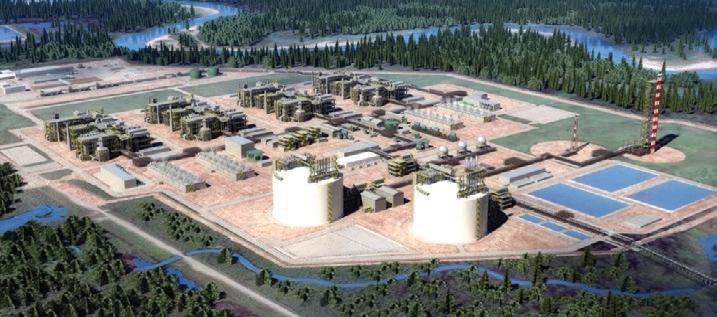
11 minute read
Trade Winds: Cuba, Japan and Malaysia
Cuba: An open door to investment and trade
By Josefina De La Caridad Vidal Ferreiro
Advertisement
Since the beginning of the 1960s, Cuba’s economy has been slowed down by the economic blockade imposed by the U.S. government, which, due to its extraterritorial scope, affects not only the functioning of Cuba itself, but also its foreign relations. As such, the Cuban economy and its links with the outside world have operated and continue to operate in a highly complex environment, facing enormous difficulties and obstacles.
Cuba is the largest island in the Caribbean so our government policy prioritizes research and technological innovation and basic infrastructure throughout the country, with communication networks, railroads, highways, airports and ports that allow deep-sea vessels to dock. The most modern of ports is located in the Mariel Special Development Zone, west of Havana, which is destined to become the main entry and exit door for Cuban foreign trade.
Cuba maintains diplomatic and consular relations with 187 countries. It is a member of numerous international and regional organizations that have allowed it to sign multiple multilateral agreements, as well as bilateral agreements on economic co-operation. It maintains commercial relations with more than 160 countries — among them Canada, which has had a significant historical presence in the Cuban economy.
Trade between Canada and Cuba exceeded $1.4 million. Canada is Cuba’s fourth-largest commercial partner and the primary market for Cuban goods exports, which primarily include nickel, tobacco, rum and sea products. Other goods, such as coffee, fruit and vegetables have been added to this list in recent years.
The most modern port is located in the Mariel Special Development Zone, west of Havana, which is destined to become the main entry and exit door for Cuban foreign trade.
Canada is the second-largest investor on the island. Over the decades, Canadian companies have shared the risks and benefits of participating in the development of strategic sectors such as mining, energy, agri-business and tourism.
Cuba has natural, political, legal and social advantages, including an incentive regulatory framework and a broad business portfolio, which make the country an attractive and safe destination for Canadian trade and foreign investment.
When it comes to foreign investment, Cuba currently offers a portfolio with 460 projects in such sectors as energy and oil, agri-business, mining, renewable sources of energy, light and heavy industries, and biopharmaceuticals. In these sectors, Canada is an innovative leader and one of the main investors on the island.
Trade-wise, Cuba offers several agrifood products it could export to Canada. These include honey; black vegetable charcoal from native woody plants, bagged and free of dirt and dust; hot chilis, high in vitamins A and C; avocados, mangoes, pineapples, Persian limes and sweet potatoes, all fresh; and curcuma in dry powder form and without the direct intervention of solar rays.
For further information on the potential for trade and investment opportunities in Cuba, we invite you to visit the official pages of the Ministry of Trade and Foreign Investment (www.mincex.gob.cu/ index.php/portal) and the Centre for the Promotion of Foreign Trade and Foreign Investment (http://www.procuba.cu/ en). You can also contact the embassy in Ottawa, Canada (misiones.minrex.gob.cu/ en/canada).
Josefina De La Caridad Vidal Ferreiro is the ambassador of Cuba to Canada. Phone her at (613) 563-0136 or email to embacuba@embacubacanada.net
Japan and Canada should amp up trade
By Yasuhisa Kawamura
Japan and Canada have a longstanding friendly relationship and share universal values such as freedom, democracy, human rights and the rule of law. We are confident that Japan could be the best bridge-builder between Canada and the Indo-Pacific region. Last year, Japan and Canada celebrated the 90th anniversary of diplomatic relations between our two countries. As ambassador of Japan in Canada, I have the luxury of doing my utmost to further develop the already excellent relations as we move towards the centennial anniversary.
For the past several months, our joint efforts to combat the COVID-19 pandemic have been our first priority. While we forged ahead with the largest stimulus packages and took rigorous measures to mitigate its economic and social impacts, Japan and Canada must co-operate in order to ensure the flow of vital medical supplies and work together to minimize disruptions to trade and global supply chains. It is encouraging that as G7 and G20 partners, we are leading the discussion on these issues.
Two-way trade and investment has increased over the past decade. Between 2010 and 2019, Japan’s exports to Canada increased from approximately $10.6 billion to $12.58 billion, while Canada’s exports to Japan increased from an estimated $12.45 billion to $16.75 billion. Over the similar period, the FDI stock from Japan to Canada increased from $12.7 billion in 2010 to $28.9 billion in 2018. In addition, there are some notable interdependent relationships with respect to specific products. For instance, canola, lumber and coal make up a large share of Canada’s exports to Japan. Conversely, about half of the automobiles manufactured in Canada are

LNG Canada, a $40-billion project, represents Canada’s largest and most promising investment project, and Japan has made substantial investment in it.
Japanese brands.
Despite these encouraging highlights, overall exports and investment shares continue to be unremarkable. Japan’s share of total exports to Canada amounted to two per cent in 2018, while Canada’s share of total exports to Japan was one per cent that year. FDI stock tends to follow the same trend.
Given that there is still so much potential, I strongly believe we can further develop our bilateral relations. We are now partners in the CPTPP, which establishes high standards in trade and investment in the Asia-Pacific. If we take advantage of these commonalities, they can form a foundation for the next phase of our economic relationship.
The question is, how can we capitalize on this huge potential and successfully navigate our bilateral relationship to the next chapter? The answer to this lies in identifying the priority areas for bilateral co-operation and committing to them. For instance, the two countries could cooperate towards the realization of a free and open Indo-Pacific. Furthermore, as free-trading nations, it is of utmost importance for us to promote and protect a rules-based trading environment from the rising tide of protectionism. To this end, Japan and Canada could enhance cooperation in support of WTO reform, and in ensuring that the rules implemented under the CPTPP are properly maintained and expanded.
We could further co-operate in the energy sector, with a focus on LNG and the development and export of clean energy. LNG Canada, a $40-billion project that is expected to start exporting LNG in the mid 2020s, represents Canada’s largest and most promising investment project, and Japan has made substantial investment in it. In the field of innovation, Canada has human resources and hubs for the world’s most advanced artificial intelligence, including deep-learning. Increased co-operation could also be possible through the promotion of a better business environment and enhanced exchange of trade missions and networking among businesses, including small- and medium-sized enterprises.
The CPTPP is a model of what we can achieve when Japan and Canada work together. Under the CPTPP, exports of Canadian beef and pork to Japan and exports of Japanese steel products and automobile parts to Canada have increased. However, many areas remain unexploited, including the export of Japan’s agricultural products, such as wagyu beef, sake, whisky, fishery products and green tea to member countries, including Canada.
The CPTPP is a high-level, 21st-Century agreement that makes global trade and investment freer, fairer and more transparent. Japan and Canada, as the two largest economies among the original members, continue to collaborate with one another to promote the utilization of this multilateral economic framework to increase trade and investment in the Indo-Pacific region.
Yasuhisa Kawamura is Japan’s ambassador to Canada. Reach him at infocul@ ot.mofa.go.jp or (613) 241-8541.
More trade with Mali is welcome
By Fatima B. Meite
Mali is at a crossroad of civilizations — a country rich in history and home to diverse cultures. Most often known for its legendary city, Tombouctou, Mali is a country of commerce and was, for a long time, at the heart of major trans-Saharan trade.
Mali occupies a strategic geographical position in the heart of West Africa, with robust infrastructure, including 12,860 kilometres of roads connecting Nouakchott, Dakar, Conakry, Abidjan, Ouagadougou and Niamey to Bamako, its capital.
The country’s economy is based on agriculture, which accounts for 39.5 per cent of GDP. It is the second-largest producer of cotton in Africa, producing more than 500,000 tons per year. In addition, it is the third-largest producer of gold in Africa, with production of 50 tons per year. Mali also has significant reserves of iron (two million tons), bauxite (1.2 million tons), uranium (5,000 tons) and other resources, such as phosphate, copper, lead, zinc, lithium and limestone.
Despite a security crisis, Mali has one of the fastest and most resilient economic growth rates in West Africa. Annual GDP growth hovers around 5 per cent. Inflation is controlled at -1.7 in 2019, according to the World Bank.
Mali has maintained a sustained pace of reforms aimed at improving the investment climate. It has repeatedly distinguished itself as one of the most dynamic countries in the region in terms of reforms over the past decade, according to the World Bank’s Doing Business report.
Canada and Mali have a well-established trading relationship, with significant growth potential. The two countries signed an investment promotion and protection agreement that came into force

Mali is the third-largest producer of gold in Africa, with production of 50 tons per year. Sadiola Gold Mine is located in southwest Mali, near the border with Senegal.
in June 2016. This agreement further promotes and guarantees investments between the two countries.
In addition, Mali has put in place a number of incentive and advantageous tax provisions and regulations favourable to investment. The country has implemented several bold sectoral policies to facilitate mining, petroleum, agricultural and energy investments.
In 2018, bilateral merchandise trade between Mali and Canada reached $23.1 million — including $20.9 million from Canada to Mali, largely in machinery, vehicles and parts, among others, and $2.2 million from Mali to Canada, including canned food and mango juice.
Two Canadian companies, B2Gold and Robex Resources Inc., opened gold mines in Mali in the past three years. The B2Gold mine is one of the largest and represents an investment of more than $600 million. Other Canadian mining companies in Mali are Iamgold and Endeavour Mining Corporation. Canadian mining assets in Mali are worth $1.8 billion and Canadian investment tops $118 million.
Mali is a country that provides opportunities for Canadian companies in various sectors, including mining, energy, agriculture, infrastructure, clean technology and education.
Indeed, a total energy efficiency deficit of 22,600 gigawatt hours is expected by 2030. Demand is at all levels — government, industrial and residential. The hydroelectric potential is estimated at 1,150 megawatts and 5,600 gigawatt hours per year, of which only 300 megawatts are currently exploited. The duration of sunshine varies between 8 and 10 hours per day, producing between 5 and 7 kilowatt hours per square metre of surface per day. Mali boasts more than 300 days of sunshine and more than 600 millimetres of precipitation per year.
The land for solar energy production sites is ceded free of charge by the state. Initial research reveals five basins with high potential for oil and gas. New legislation encourages their exploration.
The southern part of Mali presents ideal conditions for growing a range of oil seeds, including rice and corn. Less than 10 per cent of the estimated 40 million hectares of arable land is cultivated. Mali is the largest producer of livestock in West Africa, with 30 per cent of the total livestock. It is also a large producer of cereals used in the production of livestock feed.
My embassy has implemented an economic diplomacy strategy with Canada and the first step was to create the Canada-Mali Chamber of Commerce in June 2020. This Canadian organization will allow us, in a global, integrated, coherent and dynamic manner, to strengthen economic relations and develop trade between Canada and Mali. It will bring together and mobilize business people from both countries and the diaspora to contribute to the development and economic prosperity of Canada, as well as to the dynamism of the economy of Mali.
Fatima Braoulé Méïté is the ambassador of Mali. Reach her at ambassade@ambamali.ca or (613) 232-1501.





















